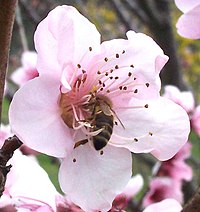
Honey Bee (Apis mellifera) Exposure to Pesticide Residues in Nectar and Pollen in Urban and Suburban Environments from Four Regions of the United States
Sign Up to like & getrecommendations! Published in 2022 at "Environmental Toxicology and Chemistry"
DOI: 10.1002/etc.5298
Abstract: The risk of honey bee (Apis mellifera L.) exposure to pesticide residues while foraging for nectar and pollen is commonly explored in the context of agroecosystems. However, pesticides are also used in urban and suburban… read more here.
Keywords: nectar pollen; honey bee; pesticide residues; urban suburban ... See more keywords

Insecticide dose and seasonal timing of trunk injection in apples influence efficacy and residues in nectar and plant parts.
Sign Up to like & getrecommendations! Published in 2019 at "Pest management science"
DOI: 10.1002/ps.5268
Abstract: BACKGROUND Trunk injection is an established method for delivering pesticides in ornamental and shade trees, but further research is needed to determine efficacy and pollinator safety in tree fruit crops. Apple trees were injected in… read more here.
Keywords: trunk injection; trunk; emamectin benzoate; nectar pollen ... See more keywords

Nectar and pollen sources for honeybees in Kafrelsheikh province of northern Egypt
Sign Up to like & getrecommendations! Published in 2019 at "Saudi Journal of Biological Sciences"
DOI: 10.1016/j.sjbs.2017.12.010
Abstract: This study was conducted at the apiary of the Beekeeping Research Section at the Sakha Agricultural Research Station, ARC, Kafrelsheikh, and other apiaries in Kafrelsheikh province, during two successive years 2015 and 2016. The study… read more here.
Keywords: sources honeybees; province; nectar pollen; pollen sources ... See more keywords

Nectar and Pollen Phytochemicals Stimulate Honey Bee (Hymenoptera: Apidae) Immunity to Viral Infection
Sign Up to like & getrecommendations! Published in 2017 at "Journal of Economic Entomology"
DOI: 10.1093/jee/tox193
Abstract: Abstract Parasites and pathogens are implicated in honey bee colony losses, and honey bees may also spread infection to wild pollinators. Bees consume nectar and pollen, which contain phytochemicals that can positively or negatively affect… read more here.
Keywords: honey; infection; honey bee; nectar pollen ... See more keywords